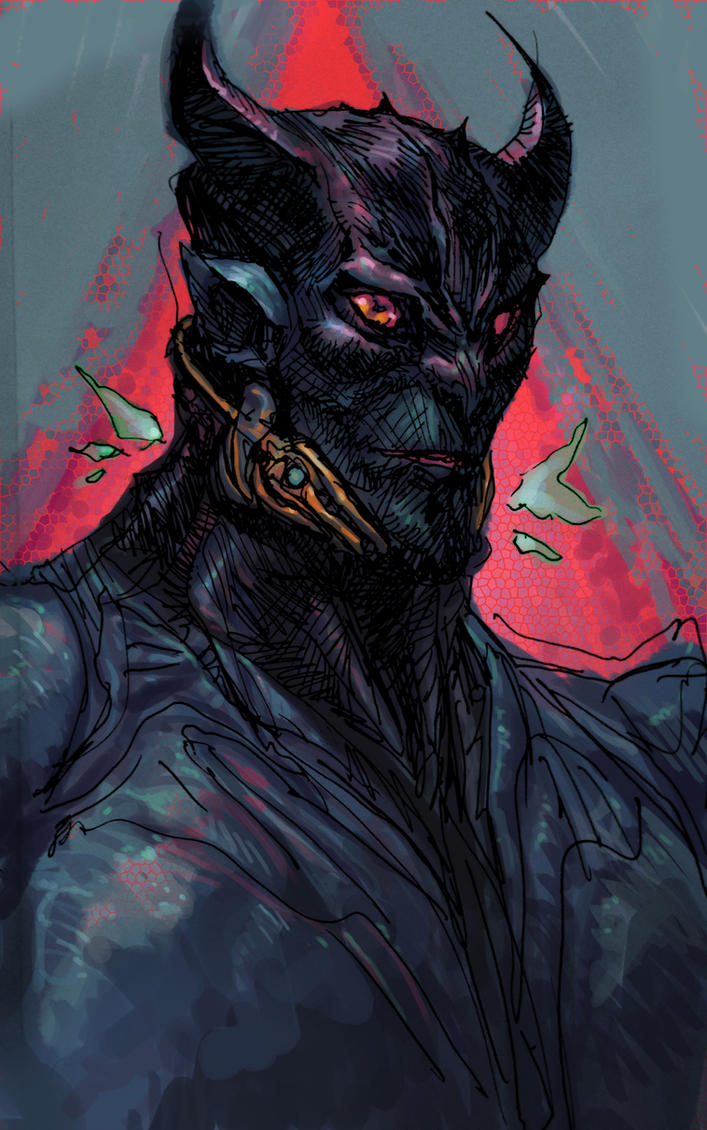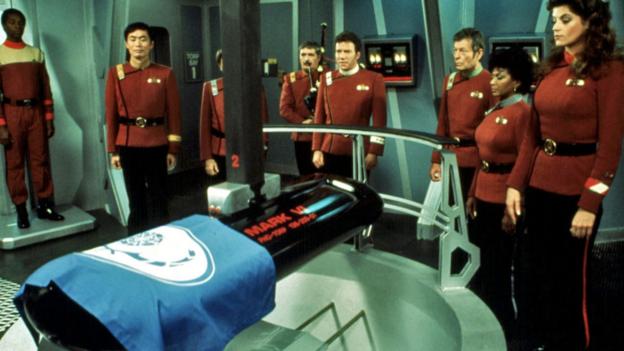1 hour ago
Friday, March 6, 2015
Strange Stars Up North
Earlier this week, John Till posted a session report from Con of the North of another Strange Stars Fate playtest. This one included a Vokun animal transport ship, a stoner dude AI, and of course, space pirates.
Read all about it here.
Thursday, March 5, 2015
Deals With the Devils
 |
| Art by Paul Harmon |
The Diaboli are a clade, a culture, or maybe a corporate entity that despoil worlds and corrupt other cultures—even whole universes—with faustian bargains of advanced technology and metaphysical knowledge. Maybe they've tempted some with miracle cures for disease or solutions for world hunger, but more often they appeal to baser instincts with advanced weapons of war or aids to the pursuit of pleasure. Whatever they offer, the cost is inevitably high--too high. The Diaboli are quick to sell fixes for the problems that arise, which inevitably just make things worse. At every turn, the Diaboli enhance their material wealth and create misery from which they are able siphon metaphysical energy. Some of their victims survive the devastation of their previous culture to become junior Diaboli themselves, and the toxic memeplex propagates like a multiversial pyramid scheme.
The Diaboli are very old; some believe they are the degenerate remnant of the Precursors who built the Ways. The truth, though, (at least as much as can be gleaned from a group as duplicitous as this one) is that the Diaboli fear the apotheosed Precursors. They believe the Precursors' Judgment is coming someday—and they plan to deny that judgment by becoming powerful enough fight back against gods. Only by draining or corrupting all potential rivals do they believe this end to be achievable. They view this as a net good for the entire multiverse and see themselves as defenders of order and civilization, albeit one where their inherently superior culture is in power.
Wednesday, March 4, 2015
Multiversal Spotlight: Earths Stan & Jack
Concept: Earth of Stan Lee's Just Imagine
Pictured: (left to right) Flash (Mary Maxwell), Green Lantern (Leonard Lewis), Batman (Wayne Williams), Superman (Salden), Wonder Woman (Maria Mendoza), Shazam (Robert Rogers).
Sources: The Just Imagine Stan Lee... series of oneshots 2001-2002.
Analogs: None.
Comments: In the Just Imagine series, Stan Lee re-imagined a number of DC characters and even Crisis with the help of various artists: Joe Kubert (Batman), Jim Lee (Wonder Woman), John Buscema (Superman), Kevin Maguire (the Flash), Dave Gibbons (Green Lantern), John Byrne (Robin), Gary Frank (Captain Marvel), Scott McDaniel (Aquaman), Catwoman (Chris Bachalo), Sandman (Walt Simonson), JLA (Jerry Ordway), and John Cassaday (Crisis).
Note that Earth-6 and Earth-51 occupy opposing positions in the Multiversity map, with Earth-6 connected to the Pit (Apokolips) and Earth-51 to the Pinnacle (New Genesis).
Earth-51
Concept: Earth of Jack Kirby creations
Pictured: (left to right) Lightray, Tuftan, Mister Miracle, Highfather, Kamandi, Big Barda, BiOMAC, ?.
Sources: Kamandi, The Last Boy on Earth (1972), New Gods (1971), OMAC (1974), Final Crisis (2008).
Analogs: Pre-Crisis Earth-86 was identified as the home of Kamandi and OMAC in Absolute Crisis on Infinite Earths (2006); Post-52 Earth-15 in home to a version of Kamandi as established in 52 Week 52 (May 2007), but after being recreated by Nix Uotan, Earth-51 is also home to Kamandi and ultimately the New Gods at the end of Final Crisis.
Comments: The earlier versions of a Kamandi Earth were also the home of other non-Kirby characters that have been tied in to the Great Disaster: the Atomic Knights and Hercules. There is no indication that those characters exist on Earth-51. The version of OMAC here ("BIOMAC") differs from previous versions of the character, at least in name.
Monday, March 2, 2015
Ways & Sigils
When humanity discovered there was a way to cheat relativity, we would, to our surprise, that it was a lot like magic. The paths that shortcut distance and connected many universes were built by ancients no species remembered--though everyone had stories. A popular one was that the precursor culture came from outside the ordered universes, from a manifold or bulk whose physical laws would have been more familiar to Jung or Frazer than Einstein or Hawking. We called it "hyperspace." It sounded more scientific than "the astral plane."
Computers, even the most advanced AI, were mostly confused by the ways. They could tell you a lot about the apertures, but they couldn't decipher the symbols that needed to be inscribed on the surface of hulls of craft in order to make the apertures open or to arrive safely at a desired destination. And so the casters arose; they were people with the mental aptitude to understand the ways and create the symbols needed to traverse them successfully. With a good caster, a vessel can get almost anywhere.
Sometimes, though, ships wind up someplace other than their intended destination or just disappear entirely. At times the casting is probably to blame; encoding multidimensional state vectors into a compressed symbolic representation has always been more intuition than science, and the internal state of the caster has always been a variable. Sometimes there's just a glitch--an act of god, you might say. Who knows what might distract the hypersophont entites or idiot gods in the machine of the multiverse that "read" the sigils and guide ships to their destinations?
So the lucky and lost just wind up making an extra stop or two before their final destination. The unlucky truly lost disappear entirely. But there are a few, the stories say, that turn after a long absence with strange stories. There's a city at the center of the multiverse, these haunted-eyed travelers say. A city where castaway alien vessels from infinite universes wind up. A city so vast, so old, so integral, that it doesn't have a name, just a single location sigil-- the Sigil. That's what they call it.
Computers, even the most advanced AI, were mostly confused by the ways. They could tell you a lot about the apertures, but they couldn't decipher the symbols that needed to be inscribed on the surface of hulls of craft in order to make the apertures open or to arrive safely at a desired destination. And so the casters arose; they were people with the mental aptitude to understand the ways and create the symbols needed to traverse them successfully. With a good caster, a vessel can get almost anywhere.
Sometimes, though, ships wind up someplace other than their intended destination or just disappear entirely. At times the casting is probably to blame; encoding multidimensional state vectors into a compressed symbolic representation has always been more intuition than science, and the internal state of the caster has always been a variable. Sometimes there's just a glitch--an act of god, you might say. Who knows what might distract the hypersophont entites or idiot gods in the machine of the multiverse that "read" the sigils and guide ships to their destinations?
So the lucky and lost just wind up making an extra stop or two before their final destination. The unlucky truly lost disappear entirely. But there are a few, the stories say, that turn after a long absence with strange stories. There's a city at the center of the multiverse, these haunted-eyed travelers say. A city where castaway alien vessels from infinite universes wind up. A city so vast, so old, so integral, that it doesn't have a name, just a single location sigil-- the Sigil. That's what they call it.
Sunday, March 1, 2015
Revisiting Where No One Has Gone Before
In memoriam of Leonard Nimoy and his iconic role as Spock on Star Trek, I thought it would be a good time to index the Star trek posts I did (mostly for Starships & Spacemen) back when we had a short-lived campaign going in 2013.
I statted up several obscure species mentioned or given cameos in the series/films:
Arcturians
Cygnians
Kazarites
Ithenites
Nasat
Orions
Skorr
Here are the outline and notes on one of the adventures I ran: "The Clarity of Crystal"
I hope you enjoy them. Play a Star Trek game and remember the great character and series Nimoy helped bring us.
I statted up several obscure species mentioned or given cameos in the series/films:
Arcturians
Cygnians
Kazarites
Ithenites
Nasat
Orions
Skorr
Here are the outline and notes on one of the adventures I ran: "The Clarity of Crystal"
I hope you enjoy them. Play a Star Trek game and remember the great character and series Nimoy helped bring us.
Friday, February 27, 2015
Fate of the Strange Stars
Yesterday, John Till posted a play report of one of his Strange Stars Fate games at Con of the North. Head over and check it out. John is almost done with the writing of the Fate game book so we'll be going to layout soon.
Also, here's a review from a week and a half ago by Courtney over at Hack & Slash.
Thursday, February 26, 2015
Wild Wild West
Wild Wild West was conceived as "James Bond on horseback." That was a just-about perfect genre combo for the 1965, and a damn good one for today. The actual show was even cooler, particularly when it went color; it was the Old West filtered through 60s spy-fi style with Jules Verne science fiction thrown in. It's practically begging for an rpg.
The show's James Bond of the 1870s was James West, Secret Service agent, who rode around in a private train with his partner, gadgeteer and master of disguise Artemus Gordon. Bruce Lansbury, producer of the show, described it thusly (as quoted in Susan Kesler's book):
"Jim's world was one of two-faced villainy, male and female, countless 'Mickey Finns,' and needle-tipped baroque pinkie rings that put him to sleep even as he embraced their dispensers. There were inevitable trap doors, hotel walls that ground their victims to dust or revolved into lush Aubrey Beardsley settings next door, lethal chairs that tossed occupants skyward or alternatively dumped them into dank sewers that subterraneously crisscrossed countless cow towns of the period. And then there was that old Dutch sea captain, leaning in the corner of the swill-hole of a bar, who inexplicably winked at Jim as he entered … Artemus, of course, in one of his thousand disguises."Some highlights: a super-speed formula made from diamonds; an elaborate house full of traps made by a deranged puppeteer; a ground of assassins masquerading as a circus troupe; and of course, the genius dwarf, Miguelito Loveless.
(No doubt some of you remember the 1999 film of the same way. It's fine, sort of in the way the 1998 Godzilla is fine. If you're a fan of the original show, though, it's rather like a breezy remake of Star Trek with Will Smith is Kirk and also the performer of the theme song.)
Anyway, in gaming Wild Wild West, a lot of folks would suggest Steampunk games first--but the Steampunk aesthetic is pretty much missing from the show, despite the superficial similarities in thumbnail description. Any Western rpg (or generic one) would work, I suppose--so long as it would support the Victorian super-science. The Western element is mostly cosmetic, though, Stripped of its trappings, it more resembles The Man from UNCLE at its core than say Wagon Train. I think a Western adaptation of the old James Bond game would be interesting with the spy-fi genre stuff it has built in. GUMSHOE might also be a good way to do it.
Subscribe to:
Comments (Atom)



%2B001-030-Earth-6.jpg)
%2B001-058.jpg)












